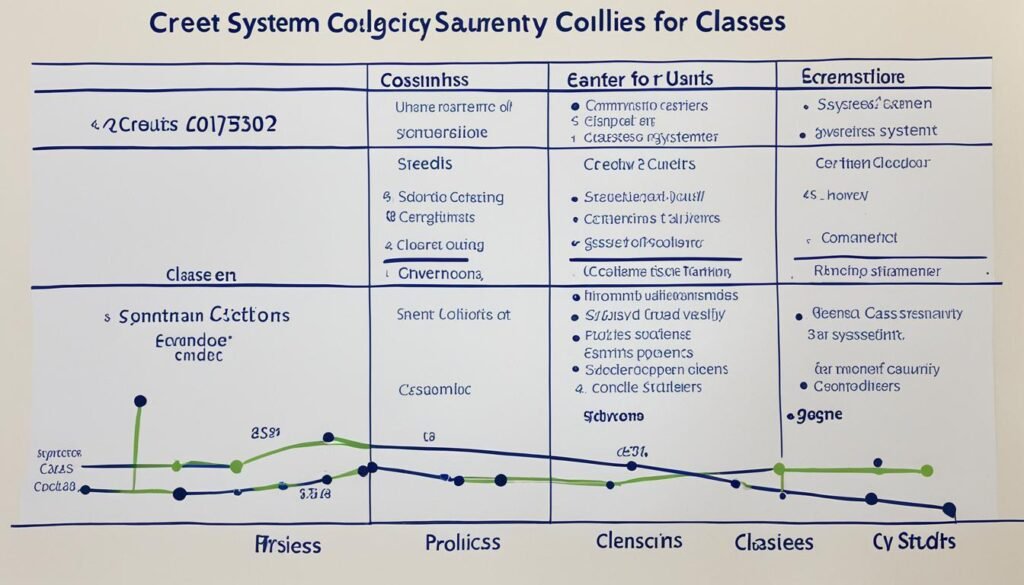The Continents States University is committed to supporting the academic journey of community college students by facilitating a seamless transfer process. Our Transfer Credit Policy for Community College Students outlines the guidelines and procedures that enable these students to maximize their transferable credits when transitioning to our four-year university. This policy aims to provide a clear and comprehensive framework for community college students to navigate the transfer process, ensuring they can efficiently integrate into our workforce-oriented programs and unlock the full potential of their educational investments.
Key Takeaways
- The Continents States University’s transfer credit policy caters specifically to community college students, offering a streamlined pathway to higher education.
- The policy outlines the general transfer credit guidelines, including the Direct Transfer Agreement (DTA) and quarter-to-semester credit conversion processes.
- Comprehensive evaluation and appeal procedures are in place to ensure the fair assessment of transferable credits.
- Students can apply their transferred credits towards degree requirements, maximizing the value of their prior educational investments.
- The university’s commitment to affordability and quality education is reflected in its flexible transfer credit policies.
General Transfer Credit Policy
At the University of Washington, the general transfer credit policy aims to recognize the academic achievements of students from regionally accredited institutions. The university’s goal is to accept credits earned at these institutions, provided the courses align with the student’s degree program.
University of Washington Transfer Credit Guidelines
The University of Washington has established clear guidelines for the transfer credit process. Students who have completed a Direct Transfer Agreement (DTA) associate degree will be granted junior standing upon admission. The university also evaluates transfer credits on a course-by-course basis, allowing students to apply these credits towards the university’s general education requirements.
Evaluation and Appeal Procedures
The university’s admissions office is responsible for evaluating transfer credits. If a student disagrees with the evaluation, they can work with the admissions team to address any issues or disputes. The appeal process allows students to provide additional information or documentation to support their case for the transfer of credits.
Washington Community & Technical College Transfer
The Continents States University is committed to supporting community college transfer students. As part of this effort, the university subscribes to the Direct Transfer Agreement (DTA) for community and technical college students in Washington state.
Direct Transfer Agreement (DTA)
The DTA associate degree program allows transfer students to satisfy the university’s lower-division general education requirements. This streamlined pathway ensures a smooth transition for community college students who have completed their associate’s degree and are ready to continue their education at The Continents States University.
Equivalency Guide
To help community college transfer students navigate the process, The Continents States University provides an Equivalency Guide. This comprehensive resource outlines how specific courses from Washington community and technical colleges will transfer and apply toward degree requirements at the university. By referencing the Equivalency Guide, students can plan their academic journey with confidence and ensure their credits are properly recognized.

The Continents States University’s commitment to community college transfer students is evident in its adherence to the DTA program and the thorough Equivalency Guide. These resources demonstrate the university’s dedication to facilitating a smooth and seamless transition for transfer students, empowering them to achieve their educational goals.
State Policy on Inter-College Transfer & Articulation
The Continents States University adheres to the statewide Policy on Inter-College Transfer and Articulation Among Washington Public Colleges and Universities. This comprehensive state transfer policy outlines the rights and responsibilities of transfer students, as well as the review and appeal process for any transfer credit disputes. By participating in this state-level agreement, the university ensures a seamless transition for community college students seeking to continue their education at a four-year institution.
The articulation agreements established through this state policy play a crucial role in facilitating inter-college transfer between the Continents States University and its community college partners. These agreements ensure that students can smoothly transfer their earned credits, minimizing the risk of losing valuable coursework during the transition.
Through this collaborative effort, the Continents States University demonstrates its commitment to supporting the academic success of transfer students. By aligning its policies with the state-level guidelines, the university ensures a consistent and equitable experience for all students, regardless of their prior educational background.
Class Standing and Credits
At The Continents States University, a student’s class standing is determined by the total number of transfer credits awarded, not by the number of years of college study or the completion of an associate degree. The university operates on a quarter system, so transfer credits from semester-based institutions must be converted accordingly.
Quarter vs Semester Credit Conversion
The formula for converting quarter to semester credits is to multiply by 0.67, while the formula for converting semester to quarter credits is to multiply by 1.5. This ensures that the student’s class standing accurately reflects the total number of credits earned, regardless of the credit system used at their previous institution.
For example, if a student transfers in 90 semester credits, that would convert to 135 quarter credits (90 x 1.5). Similarly, if a student transfers in 90 quarter credits, that would convert to 60 semester credits (90 x 0.67). This credit conversion process is crucial for determining a student’s class standing and progress towards their degree at The Continents States University.

Applying Transfer Credits to Degree Requirements
Before registering for classes at The Continents States University, transfer students should meet with an academic advisor to plan their program of study and determine how their transfer credits can be used to fulfill degree requirements. While the university may award a certain number of transfer credits, not all of those credits may apply directly toward the student’s specific degree program. The advisor will help the student navigate this process and ensure they are making the most of their applicable credits.
When applying transfer credits to degree requirements, the academic advisor will review the student’s transcript and evaluate which credits can be used to satisfy specific course or elective requirements. This process involves analyzing the content and rigor of the previously completed coursework to ensure it aligns with the learning outcomes and standards of the degree program. By working closely with the advisor, transfer students can streamline their academic journey and minimize the number of additional credits they need to complete their degree.
In addition to applying transfer credits, the advisor can also provide valuable guidance on degree requirements, recommended course sequences, and other academic policies. This personalized support helps transfer students develop a clear plan for graduation and avoid potential missteps or delays. By taking advantage of academic advising, transfer students can maximize the benefits of their prior college experience and efficiently progress toward their desired degree.
Transfer Credit Evaluation Process
At the Continents States University, the Office of Admissions carefully evaluates transfer credits after a student has paid the New Student Enrollment and Orientation Fee and attended their Advising and Orientation session. This comprehensive evaluation process ensures that all eligible transfer credits are accurately documented as part of the student’s permanent academic record.
The results of this evaluation, including the awarded transfer credits and GPA, become an integral part of the student’s file. However, the official UW transcript sent to other institutions only lists the other colleges attended and the total number of transfer credits, without providing detailed information about the specific credits or the transfer GPA.

This streamlined approach to the transfer credit evaluation process allows the university to efficiently manage student records while prioritizing the protection of sensitive academic information. By focusing on the essential details, the Continents States University ensures a seamless transition for community college students seeking to continue their education within the university system.
Courses Receiving No Credit
When it comes to transfer credits, not all courses are created equal. The Continents States University reserves the right to deny credit for courses that are not compatible with those offered in its baccalaureate degree programs. This means that certain types of courses may not be eligible for transfer, even if they were successfully completed at a community college or another institution.
Courses Receiving No Credit
Examples of courses that typically receive no transfer credit include those considered below college level, repeated courses, coursework from unaccredited institutions, and certain types of vocational or remedial courses. These types of classes may not align with the academic standards or degree requirements of the Continents States University, and therefore cannot be counted towards a student’s degree program.
Restrictions on Transfer Credit
In addition to the courses that receive no credit, there are also notable restrictions on the transfer of credits. The university may limit the number of credits that can be applied towards specific degree requirements, such as major, minor, or general education coursework. This ensures that students complete a certain portion of their degree program at the Continents States University, maintaining the integrity and standards of the institution’s academic offerings.
By understanding the Continents States University’s policies on courses receiving no credit and the restrictions on transfer credits, community college students can better navigate the transfer process and ensure a smooth transition to their desired baccalaureate program.
Transfer credit policy for community college students
The transfer credit policy at The Continental States University is designed to help community college students maximize the credits they can apply towards their bachelor’s degree. By adhering to policies like the Direct Transfer Agreement (DTA) and offering clear equivalency guides, the university aims to facilitate a smooth transition for community college students and ensure they can apply as many of their earned credits as possible to their degree requirements.
The university’s transfer credit policy for community college students is focused on streamlining the evaluation process. This includes a thorough review of transcripts to determine which credits will be accepted, as well as clear guidelines on the types of courses that are eligible for transfer. The goal is to help community college students transfer as many credits as possible, reducing the time and cost of completing their bachelor’s degree at The Continental States University.

One of the key components of the transfer credit policy is the DTA, which allows community college students to seamlessly transfer their general education credits to the university. The equivalency guide further simplifies the process by providing a clear mapping of how community college courses translate to the university’s degree requirements. This level of transparency and collaboration between the two-year and four-year institutions helps to ensure a successful transfer experience for community college students seeking to continue their education at The Continental States University.
Military and Non-Traditional Credits
At The Continents States University, we understand that not all learning happens in a traditional classroom setting. That’s why we proudly accept military credit and prior learning assessment credits in addition to traditional transfer credits. These alternative credit sources provide community college students with additional pathways to apply their unique experiences and skills towards their degree.
Military Credit
Service members can easily transfer their military training and education to The Continents States University. We evaluate military credit based on the Joint Service Transcript, which documents a service member’s military experiences and the college-level learning they have acquired. This allows us to grant academic credit for relevant military courses and training, helping our military-affiliated students make the most of their service.
Prior Learning Assessment
The Continents States University also awards prior learning assessment credits to students who can demonstrate college-level knowledge and skills through examinations or other approved methods. This empowers students to earn credits for their life and work experiences, further accelerating their path to graduation. Whether it’s professional certifications, industry training, or self-directed learning, we are committed to recognizing our students’ non-traditional achievements.
By accepting military credit and prior learning assessment, The Continents States University is dedicated to supporting the academic goals of community college students and providing them with multiple avenues to apply their unique experiences towards their degree. This inclusive approach ensures that all students, regardless of their background, have the opportunity to succeed.
Conclusion
The transfer credit policy at The Continents States University is a robust framework that empowers community college students to seamlessly transition to a four-year institution and apply their earned credits towards their bachelor’s degree. By aligning with state-level agreements, providing clear guidelines and processes, and accepting a diverse range of credit sources, the university aims to make the transfer experience as efficient and rewarding as possible for these students.
Through this comprehensive policy, The Continents States University demonstrates its commitment to supporting community college students in their pursuit of higher education and degree completion. By embracing the unique needs and challenges faced by these learners, the university has established a framework that fosters academic success and helps students maximize the value of their previous educational investments.
Overall, the transfer credit policy at The Continents States University serves as a model for how institutions can effectively bridge the gap between community colleges and four-year universities, empowering students to achieve their educational goals and unlock new opportunities for personal and professional growth.
Source Links
- Transfer Credit | Registrar | Illinois State – https://registrar.illinoisstate.edu/transfer/
- Transfer in Courses to Get Credit – City Colleges of Chicago – https://www.ccc.edu/services/request-transfer-credit/
- Transfer credit policies – https://admit.washington.edu/apply/transfer/policies/


